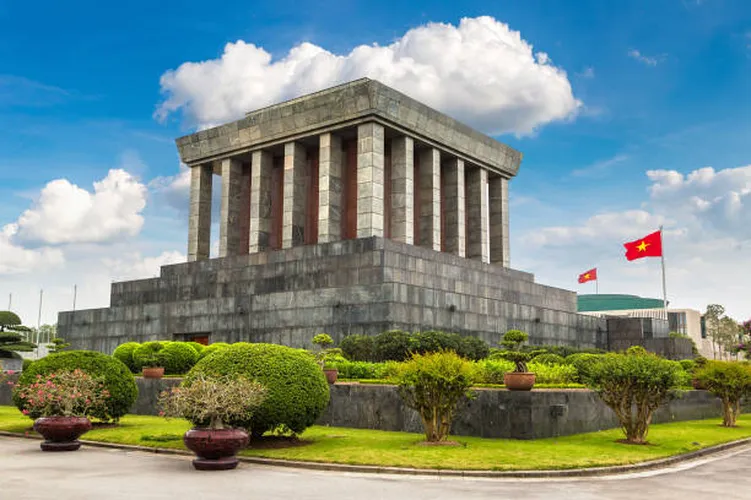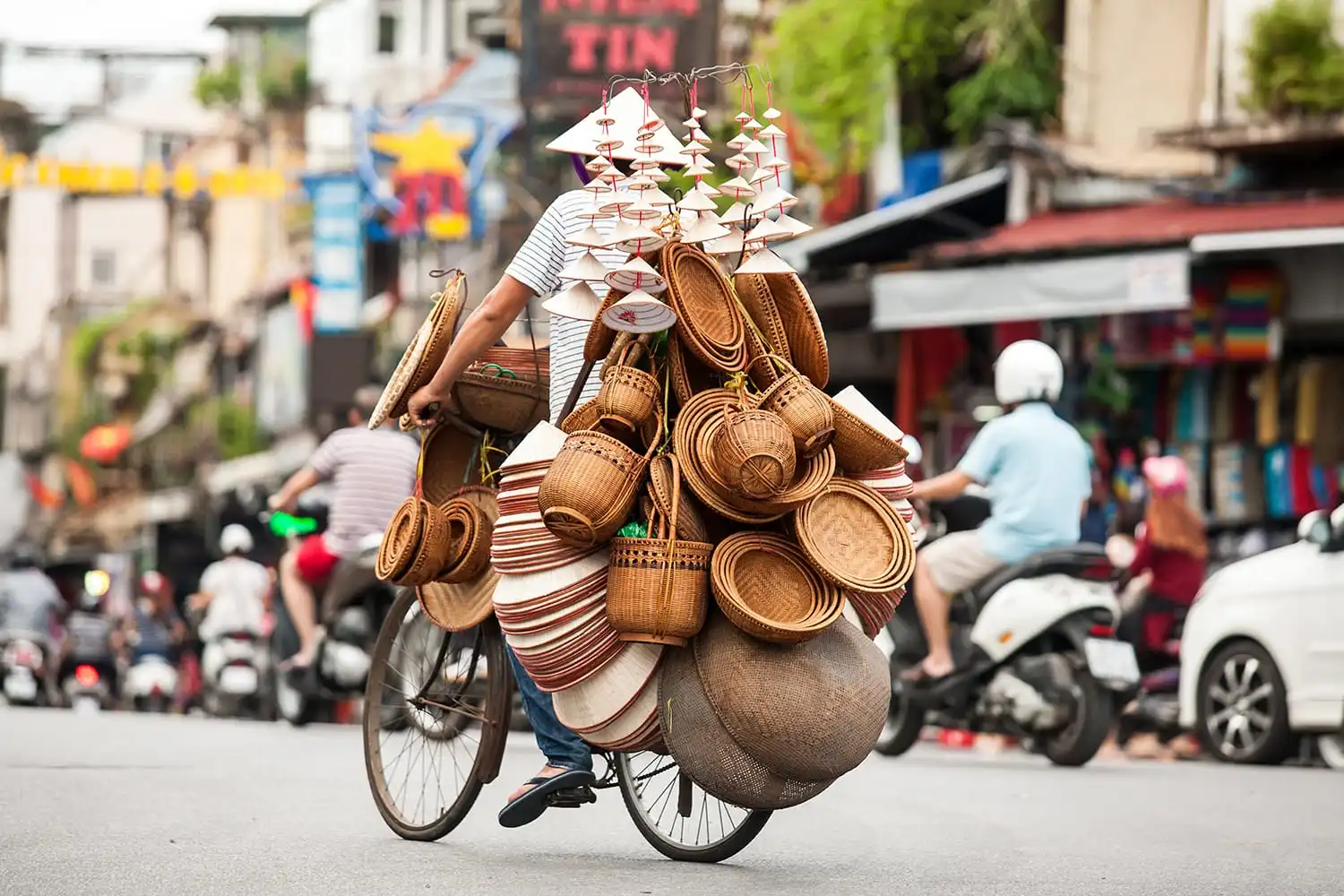If you are planning a trip to Vietnam and are looking for the one place you should schedule a visit, that would be Ba Dinh Square and Uncle Ho’s Mausoleum.
This area is the “political heart” of Vietnam. The square is a national symbol of unity and freedom, as it was at this square that Ho Chi Minh declared independence from French rule on September 2, 1945.
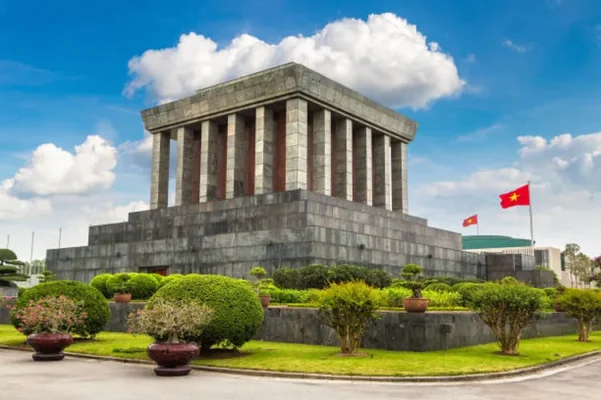
Contents
- 1 Where are Ba Dinh Square and Uncle Ho’s Mausoleum?
- 2 Uncle Ho’s Mausoleum
- 3 The History & Significance of Ho Chi Minh’s Mausoleum
- 4 The History & Significance of Ba Dinh Square
- 5 Beautiful photos of Uncle Ho’s Mausoleum and Ba Dinh Square
- 6 The highlights of Ho Chi Minh Mausoleum
- 7 The highlights of Ba Dinh Square
- 8 How to Get to the Ho Chi Minh Mausoleum?
- 9 How to Get to the Ba Dinh Square?
- 10 Accommodations for travelers to Ba Dinh Square – Uncle Ho’s Mausoleum
- 11 Other must-visit places in Ho Chi Minh Mausoleum Complex
Where are Ba Dinh Square and Uncle Ho’s Mausoleum?
Ba Dinh Square
Ba Dinh Square, the largest square in Vietnam located in front of the Ho Chi Minh Mausoleum, is an attractive tourist should take in a while visiting.
In fact, it has been a place of many crucial moments in Vietnamese history including the reading of the Proclamation of Independence of the Democratic Republic of Vietnam by President Ho Chi Minh on September 2, 1945—marking this location as the birthplace of a new Vietnam.
Especially the entire area covers 320 meters in length and is 100 meters across with broad pathways in between regions of grassy grounds; altogether able to host up to 200,000 people at any one time. Besides, the center is topped with a 25-meter-tall flagpole, where the nation’s flag is raised every morning at 6:00 AM.
- Location Address: No 8 Hung Vuong, Dien Bien, Ba Dinh, Hanoi
- Opening Days: Tuesday, Wednesday, Thursday, Saturday, and Sunday
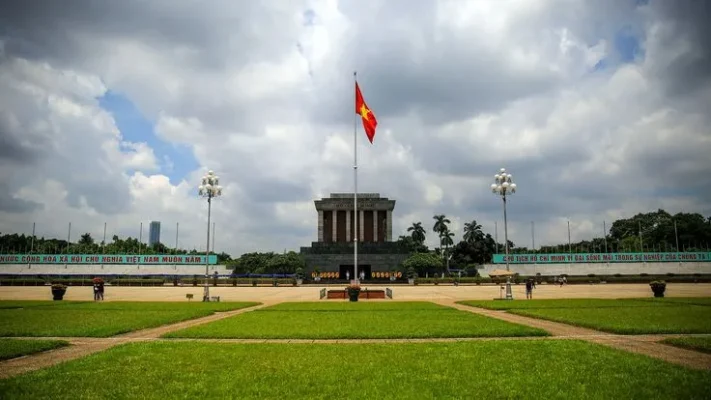
Uncle Ho’s Mausoleum
The Ho Chi Minh Mausoleum has three levels it stands 21.6 meters tall and 41.2 meters wide. Emblazoned across its portico is “Chủ tịch Hồ Chí Minh” (President Ho Chi Minh) written with dark red jade stone from Cao Bang Province.
The visitor’s lobby is adorned with red marble, featuring the inscription “Không có gì quý hơn độc lập tự do” (Nothing is more valuable than independence and freedom) as well as the President’s signature. Within the Mausoleum, embedded within a glass coffin safeguarded by four military honor guards, lays Uncle Ho’s embalmed body.
- Location Address: 25 Hung Vuong, Dien Bien, Ba Dinh, Hanoi
- Opening Days: Tuesday, Wednesday, Thursday, Saturday, and Sunday
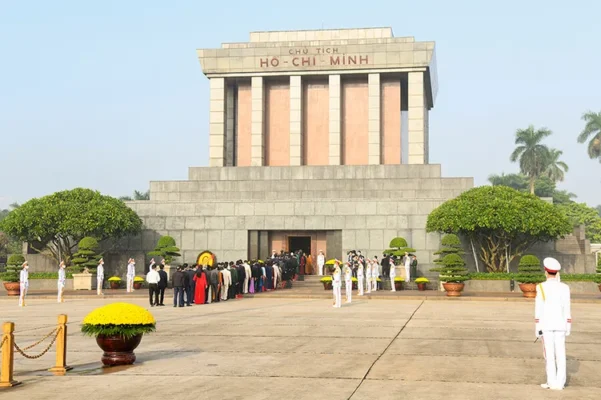
The History & Significance of Ho Chi Minh’s Mausoleum
After President Ho Chi Minh’s death, the Vietnamese government chose to keep his body and put it in the Mausoleum for the public to view and remember him.
The Ho Chi Minh Mausoleum was officially opened on August 29, 1975, and was supported by the Soviet Government. Besides, its design was inspired by Lenin’s Mausoleum in Moscow but was altered to better match Vietnamese customs and styles.
Besides, the Ho Chi Minh Mausoleum serves as a tremendous symbol throughout Vietnam and its population. For the reason for every Vietnamese inhabitant, stopping by the Mausoleum constitutes an emotional pilgrimage that enables them to display their appreciation for their nation’s famous leader.
The mausoleum is open to visitors every day from 7:30 am to 10:30 am, and it is advised to dress modestly when visiting out of respect for Vietnamese cultural norms.
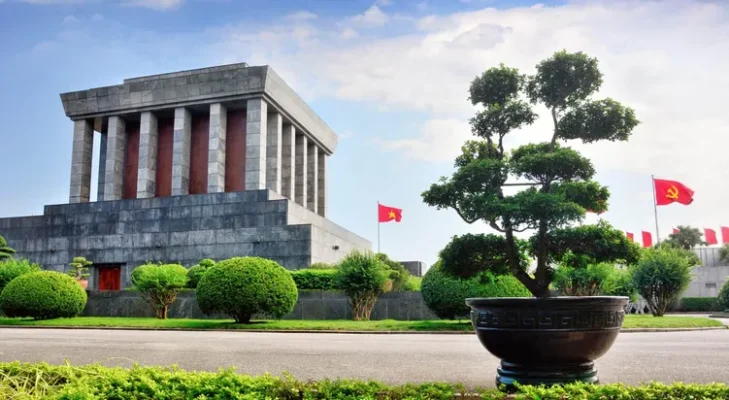
The History & Significance of Ba Dinh Square
Following Japan’s overthrow of the French forces on March 9th, 1945, Mayor Tran Van Lai made a decision to rename it to Ba Dinh Flower Garden in order to honor the uprising of the Dinh Cong Trang resistance army in Ba Dinh, Nga Son District, Thanh Hoa Province (1886-1887). After President Ho Chi Minh read the Declaration of Independence aloud at this location, it was called “Independence Square” or “Ba Dinh Square”.
Ba Dinh Square holds a significant place in Vietnamese history, as it was the site of many momentous national events. The one that stands out the most is when President Ho Chi Minh proclaimed the founding of the Democratic Republic of Vietnam – which eventually became the Socialist Republic of Vietnam – on September 2, 1945.
Half a million people from different sections of society like workers, young adults, teachers, and soldiers all huddled together in Ba Dinh Square eagerly awaiting this historic event
Beautiful photos of Uncle Ho’s Mausoleum and Ba Dinh Square
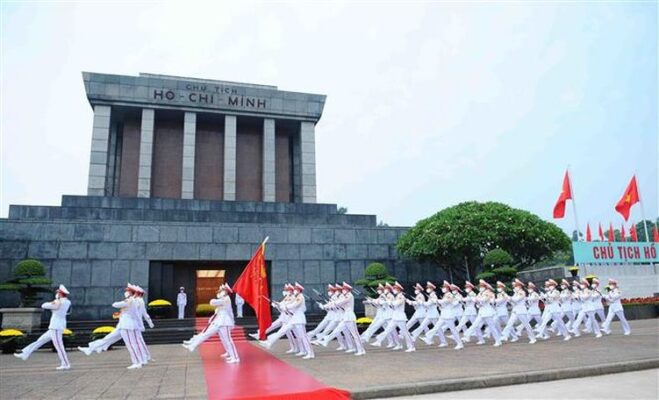
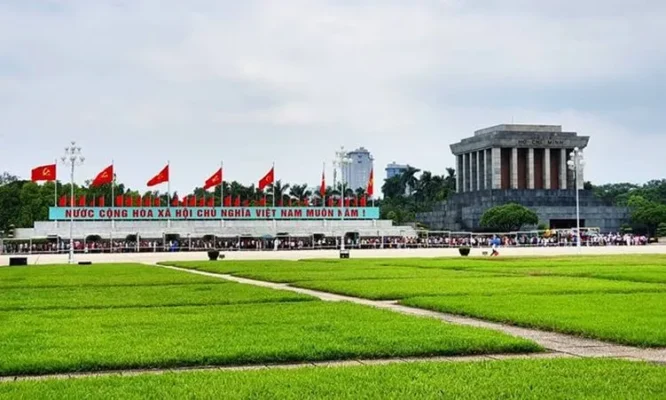
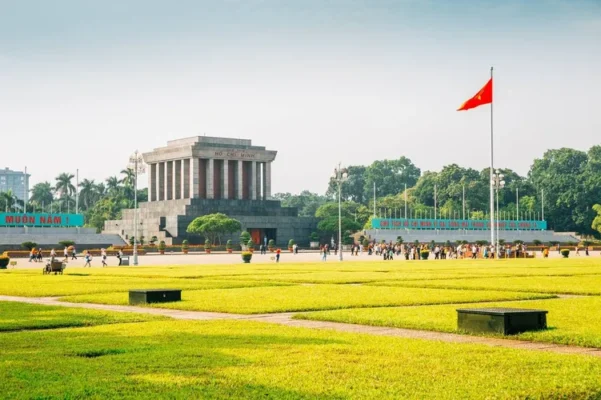
The highlights of Ho Chi Minh Mausoleum
In front of the Mausoleum stands Ba Dinh Square featuring a parade route and 79 marigold trees that symbolize former President Ho Chi Minh’s age of 79. The total appearance of Ho Chi Minh Mausoleum is an unflinching box measuring 21.6 meters in altitude and 41.2 meters in breadth, with a gray-colored outer shell made out of granite. Two guards are permanently stationed on sentry at the entrance to the mausoleum, switching up every hour.
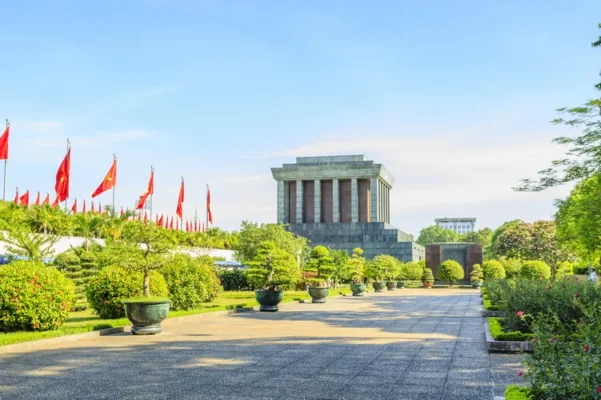
Located inside Ho Chi Minh Mausoleum is an area lined with marble. It is the spot where President Ho Chi Minh rests in a transparent glass coffin, which has a copper bed with designs similar to lotus flowers. And so made of strengthened glass, three sides of the bed permit viewers to glimpse President Ho Chi Minh wearing a light khaki shirt and plain rubber sandals. There is four military personnel on duty for surveillance inside the room.
What makes the mausoleum special is its enchanting background. Around it lies a green space with more than 250 varieties of vegetation. Until now every tree and blossom here conveys an especially distinctive significance associated with stories of Ho Chi Minh’s life while he still lived.
The highlights of Ba Dinh Square
Ba Dinh square is of utmost importance to Hanoi’s history, for there have been several crucial historical instances and national occasions that occurred within its grounds. The reason for this is it truly serves as a remarkable milestone on the city tour.
In August 1945, Vietnam finally accomplished its liberation. Ba Dinh Square became the place for the Independence Declaration ceremony. On September 02, 1945, President Ho Chi Minh – speaking on apportion of the Provisional Government – declared the Independence Declaration in Ba Dinh Square. The reason why this signifies the end of feudalism, fascism, and colonialism that oppressed Vietnam for thousands of years.
How to Get to the Ho Chi Minh Mausoleum?
Rent Motorcycles
Looking for a motorbike rental shop in Hanoi? Here are three of the best:
Gia Hung Motorcycle Rental Shop
Address: No.41 Ngo Huyen Street, Hang Trong, Hoan Kiem District, Hanoi
Tel: (+84) 93 634 51 23
Price: 4-10$
Van Chinh Motorcycle Rental Shop
Likewise:
Address: No.24D Ta Hien, Hang Buom, Hoan Kiem District, Hanoi
Tel: (+84) 98 959 55 33
Price: 4-10$
Sabo Rental Shop
Likewise:
Address: No.118 Truong Dinh, Hai Ba Trung Ward, Hang Buom, Hoan Kiem District
Tel: (+84) 969 322 246
Price: 5 – 11$
Booking a plane ticket
*Note: Ticket prices are subject to change on special occasions throughout the year
| Airlines | Journeys |
Weekday fare |
| Pacific Airlines | Saigon – Hanoi | 869,000 VND |
| Vietjet Air | Sài Gòn – Hà Nội | 950,000 VND |
| Vietnam Airlines | Sài Gòn – Hà Nội | 2,243,000 VND |
| Bamboo Airways | Sài Gòn – Hà Nội | 1,049,000 VND |
How to Get to the Ba Dinh Square?
Rent Motorcycles
Hanoi Motor Tour
Address: No. 22 Alley 463, Doi Can, Vinh Phu Ward, Ba Dinh District, Hanoi City
Tel: (+84) 905 458 386
Price: Ranges from 100,000 to 1,200,000 VND/piece/day.
Tigit Motorbikes Hanoi
Address: No. 75 lane 173 Hoang Hoa Tham, Ngoc Ha ward, Ba Dinh district, Hanoi city
Tel: (+84) 386 518 481
Price: Ranges from 150,000 to 800,000 VND/piece/day.
Motorbike Rental Hanoi
Address: No. 75 Quan Thanh, Ba Dinh district, Hanoi city (base 1)
Tel: (+84)988 717 016 – (+84)886 613 535
Price: Ranging from 130,000 – 1,500,000 VND/piece/day
Booking a plane ticket
*Note: Ticket prices are subject to change on special occasions throughout the year
| Airlines | Journeys | Weekday fare |
| Pacific Airlines | Saigon – Hanoi | 869,000 VND |
| Vietjet Air | Sài Gòn – Hà Nội | 950,000 VND |
| Vietnam Airlines | Sài Gòn – Hà Nội | 2,243,000 VND |
| Bamboo Airways | Sài Gòn – Hà Nội | 1,049,000 VND |
Accommodations for travelers to Ba Dinh Square – Uncle Ho’s Mausoleum
20 Hotel and Apartment
- Locations: 93A Doi Can, Ba Dinh, Ha Noi, Viet Nam
- Prices: 856.609 VND/room/night
Pullman Hanoi Hotel
- Locations: No 40 Giang Vo, Dong Da, Ha Noi
- Prices: 2.936.384 VND/room/night
Royal Hotel
- Locations: 19 Hang Chao, Ba Dinh, Ha Noi
- Prices: 456,907 VND/room/night
Other must-visit places in Ho Chi Minh Mausoleum Complex
Ho Chi Minh Museum
On August 31st, 1985, the building of the Ho Chi Minh Museum began and it was officially inaugurated on the 100th anniversary of President Ho Chi Minh’s birth, May 19th, 1990. The Ho Chi Minh Museum is one of the must-sees when visiting Ba Dinh Square and Uncle Ho’s Mausoleum
The museum is in the shape of a white lotus, which was known to be one of President Ho’s favorite flowers. The lotus is also a symbol of purity and refinement, which reflects the late president’s simple lifestyle. Thus the Ho Chi Minh Museum serves as a reminder of the Vietnamese people’s immense respect for their beloved leader and their determination to follow in his footsteps.
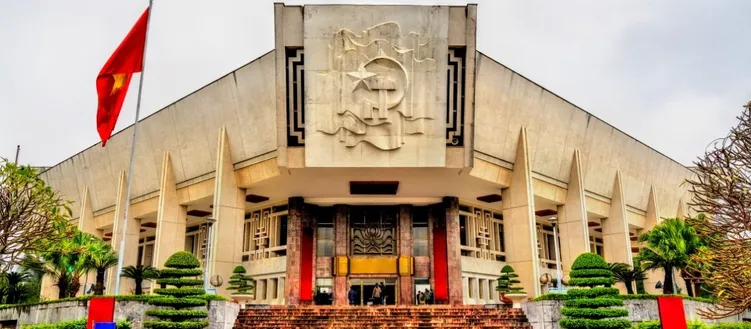
Presidential Palace
Auguste Henri Vildieu, a prominent French architect, designed the Hanoi Presidential Palace in 1906. Though this structure was meant to be President Ho Chi Minh’s official abode, he instead opted for a customary stilt house. Displaying an architectural style based on French design, the vibrantly colored three-story building boast 30 chambers and is encircled by including boulevard, an orchard, and a carp pond.
The Hanoi Presidential Palace is the second place to visit after Ba Dinh Square and Uncle Ho’s Mausoleum.
The Hanoi Palace, located to the north of the Ho Chi Minh Mausoleum, is a beautiful example of French Indochinese architecture. Today, it is used as a greeting area or guest house for foreign dignitaries. The palace commemorates the French contribution to Indochina and is a popular tourist attraction in Hanoi.
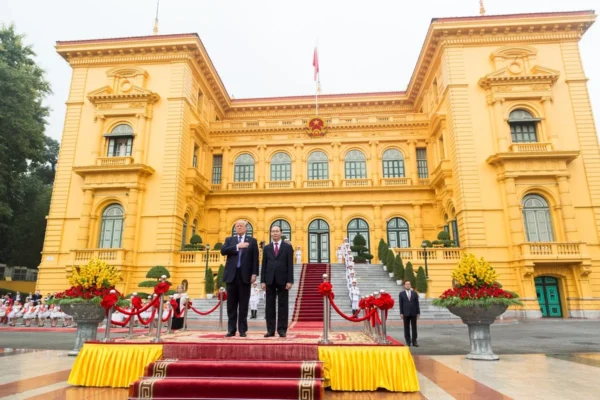
Ho Chi Minh’s House on stilts
The Ho Chi Minh Stilt House is a historical and architectural landmark in Vietnam that is representative of the country’s unique culture. The house has been crafted in the style of a traditional stilt house of an ethnic minority, measuring 10.5 meters long by 6.2 meters tall and boasting two stories and two rooms. Each room covers more than 10 m2, making it a comfortable space to use as either a bedroom or a working room.
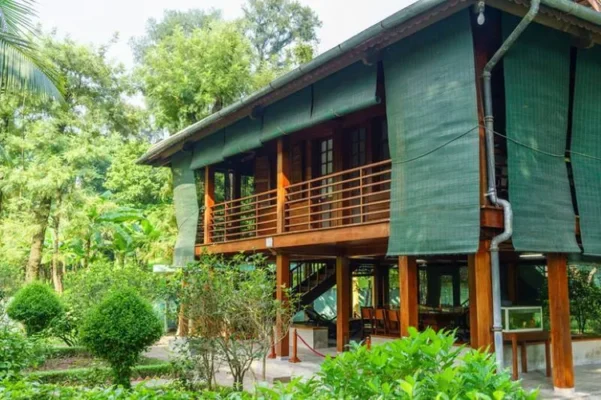
One Pillar Pagoda
The One-Pillar Pagoda, more commonly known as the Dien Huu Pagoda, is a religious monument located in Vietnam. The pagoda is named after its unique architecture, as the entire structure is built on a single pillar in the middle of a lotus pond.
The pagoda is believed to date back to the Ly dynasty and marks a significant development of Buddhism in Vietnam. Today, the monument is not only a popular tourist attraction but also a religious site for local pilgrims.
Ba Dinh Square and Uncle Ho’s Mausoleum are a must-visit for anyone visiting Vietnam. If you want to get a trip of Vietnamese culture and history, Vietnamtravelers.com will provide you with all the information you need to plan your journey.

